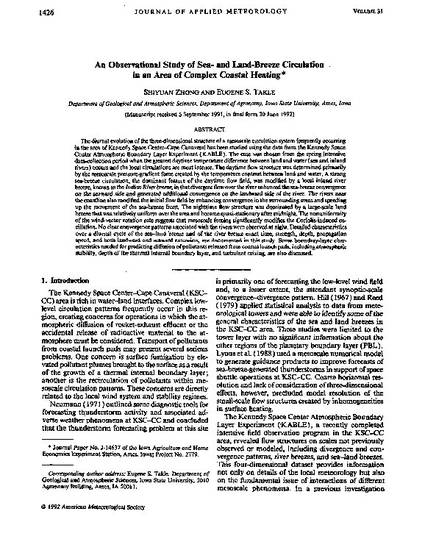
The diurnal evolution of the three-dimensional structure of a mesoscale circulation system frequently occurring in the area of Kennedy Span Center-Cape Canaveral has been studied using the data from the Kennedy Space Center Atmospheric Boundary Layer Experiment (KABLE). The case was chosen from the spring intensive data-collection period when the greatest daytime temperature difference between land and water (sea and inland rivers) occurs and the local circulations are most intense. The daytime flow structure was determined primarily by the mesoscale pressure-gradient form created by the temperature contrast between land and water. A strong sea-breeze circulation, the dominant feature of the daytime flow field, was modified by a local inland river breeze known as the Indian River breeze, in that divergent flow over the river enhanced the sea-breeze convergence on the seaward side and generated additional convergence on the landward side of the river. The rivers near the coastline also modified the initial flow field by enhancing convergence in the surrounding areas and speeding up the movement of the sea-breeze front. The nighttime flow structure was dominated by a large-scale land breeze that was relatively uniform over the area and became quasi-stationary after midnight. The nonuniformity of the wind-vector rotation rate suggests that mesoscale forcing significantly modifies the Coriolis-induced oscillation. No clear convergence patterns associated with the rivers were observed at night. Detailed characteristics over a diurnal cycle of the sea-land breeze and of the river breeze onset time, strength, depth, propagation speed and both landward and seaward extension, are documented in this study. Some boundary-layer characteristics needed for predicting diffusion of pollutants released from coastal launch pads, including atmospheric stability, depth of the thermal internal boundary layer, and turbulent mixing are also discussed.
Available at: http://works.bepress.com/eugene-takle/80/

This article is published as Zhong, Shiyuan, and Eugene S. Takle. "An observational study of sea-and land-breeze circulation in an area of complex coastal heating." Journal of Applied Meteorology 31, no. 12 (1992): 1426-1438. DOI:10.1175/1520-0450(1992)031<1426:AOSOSA>2.0.CO;2. Posted with permission.